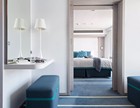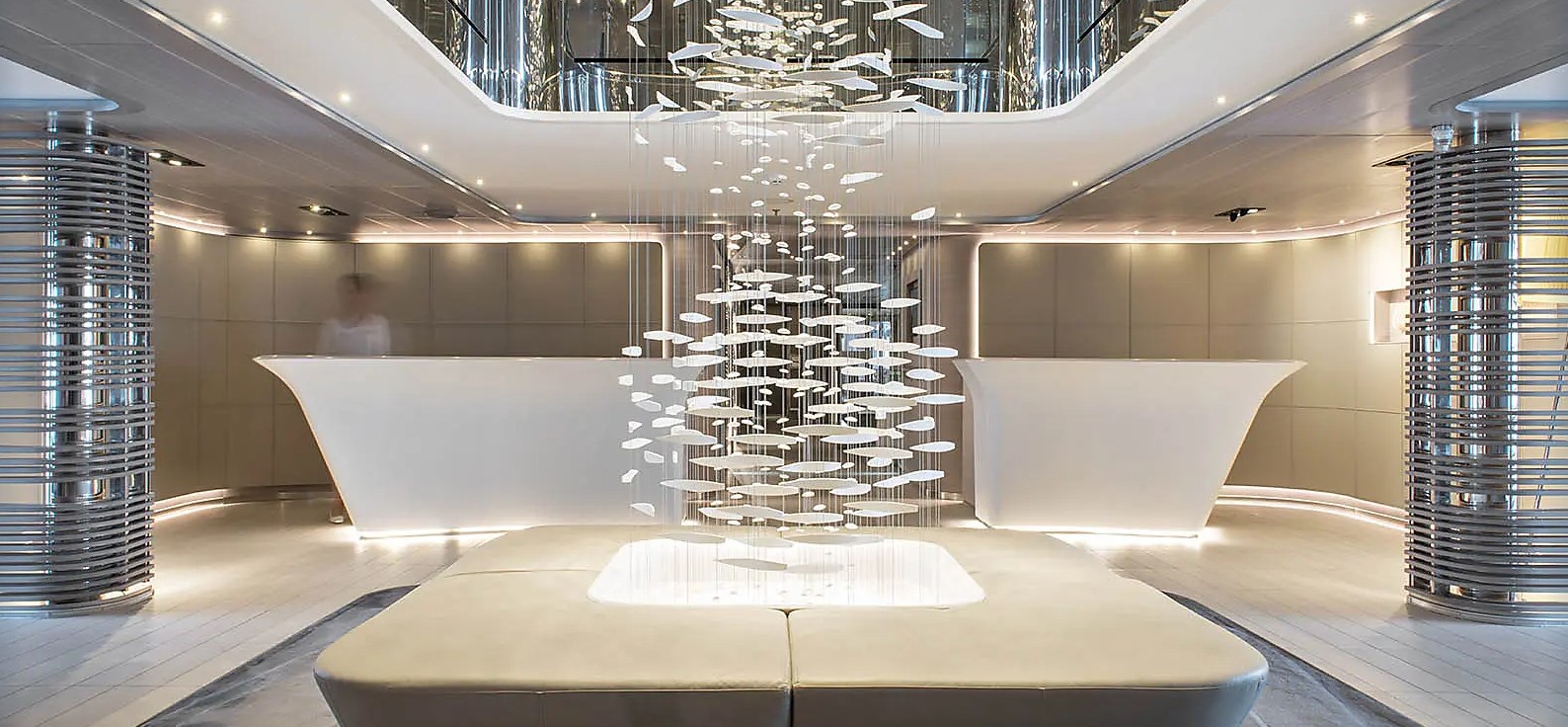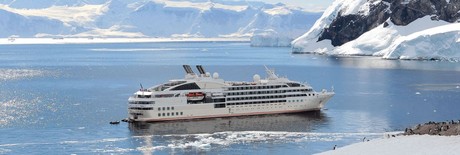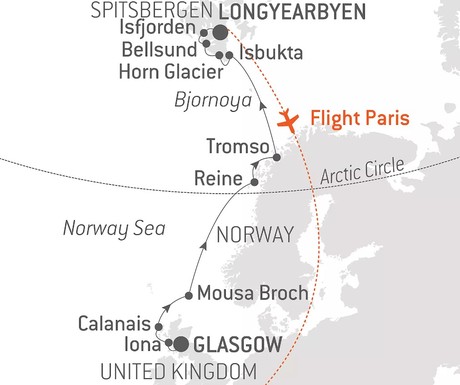From Scotland to Spitsbergen Luxury Expedition Cruise
Set off on a 14-day PONANT expedition cruise that takes you from marvellous Scottish shores to the Norwegian island of Spitsbergen. Aboard Le Lyrial, you discover the preserved landscapes of Northern Europe and the boundaries of Norway and its island, which is among the world’s northernmost.
Departing from Glasgow, Scotland's warm cultural capital with a rich artistic and architectural heritage, you will set sail for the Hebrides archipelago. You make a stop on Iona, the birthplace of Christianity in Scotland, home to an impressive abbey, and you discover Callanish on the Isle of Lewis. This port of call takes you back in time to between 2900 and 2600 BC, the period during which the island’s megalithic site would have been created… Before the circle of standing stones, aligned with the cardinal points, the mystery remains entire, the emotion is palpable.
Le Lyrial then sails towards the Shetland archipelago and the island of Mousa, which is home to Scotland’s best-preserved Broch - constructed in around 100BC, this tower-shaped fortification served to defend against invaders.
Surrounded by numerous rocky, verdant and snow-covered islets, your ship approaches the charming and historic Bronnoysund. A former Viking city, it is the gateway to the fascinating Vega Archipelago, a UNESCO World Heritage Site. Formed of dozens of islands, reefs and isolated rocks, it is a veritable nature sanctuary for many colonies of seabirds, particularly eider ducks, during their nesting period.
Further north, you marvel at the mysterious charm of the Lofoten archipelago. These islands have landscapes of surreal beauty alternating between sea, spectacular fjords, mountain slopes, fine sand beaches and huts on stilts.
Your Arctic adventure begins with your stopover in Tromso. You also sail by Bear Island, halfway between the North Cape of Norway and the South Cape of Spitsbergen. You see many seabirds, such as guillemots or Atlantic puffins, which have found refuge in the vast cliffs of the south of the island.
Even further north, you reach Spitsbergen, the main island of the Svalbard archipelago. In the land at the end of the world, millennial glaciers, steely mountains and spectacular fjords form the backdrop for whales, arctic foxes, walruses and the kings of their realm, polar bears.
Your cruise ends in Longyearbyen.
In the heart of the Clyde Valley, the bustling city of Glasgow contrasts starkly with the wild beauty of the surrounding countryside. Scotland's biggest city overflows with landmarks from its extensive artistic heritage and outstanding architectural tradition. The city's chequerboard layout makes walking through the major pedestrian thoroughfares easy: go with the flow and let the lively street atmosphere take you past the many Victorian monuments. Don't miss the collections on display in the numerous museums and art galleries. The Kelvingrove Art Gallery and Museum is an outstanding example.
Of all the islands in the Inner Hebrides, Iona is by far the most conducive to contemplation and meditation. And for good reason... it is here that St Columba landed from Ireland in 563 and undertook to establish Christianity in Scotland. Now an abbey, the islandメs true spiritual centre stands where the ancient monastery founded by the Irish missionary was built. Many kings of Scotland, including the legendary Macbeth, are buried in the nearby cemetery. In sunny weather, arriving on the Isle of Iona is a stunningly beautiful experience.
In Scotland’s Outer Hebrides, on the legendary Isle of Lewis, Callanish dazzles and surprises, fascinates and questions. On the eastern coast of the island, where land and sea rub shoulders and clash in the tumult of wild nature, discover the Callanish Stones megalithic site. No fewer than 51 stones stand in the middle of the peat fields. Deliberately arranged about 5,000 years ago, they are a mysterious testimony to the Stone Age. There are many theories as to the purpose of these stones — a place of worship, a lunar calendar, an astronomic observatory or a healing centre — but they remain an enigma. The singular atmosphere of this site lends itself to all sorts of interpretations, to all sorts of dreams and musings.
A conical dry stone tower dating back to the end of the Iron Age, the Broch of Mousa is one of the many buildings constructed in the Highlands and in the Hebrides, Orkney and Shetlands archipelagos to fend off invaders. Constructed circa 100 BC, it is the tallest broch still standing, at 13 metres (almost 43 feet), and the best-preserved in Europe. Its excellent state of perservation can be explained among other factors by its isolated location and its massive construction: it has a single entrance passage and thick walls, with a diametre that is smaller than that of other brochs. The building was used over the centuries and is mentioned in the Norse sagas, Egil's Saga and the Orkneyinga Saga.
During your day at sea, make the most of the many services and activities on board. Treat yourself to a moment of relaxation in the spa or stay in shape in the fitness centre. Depending on the season, let yourself be tempted by the swimming pool or a spot of sunbathing. This day without a port of call will also be an opportunity to enjoy the conferences or shows proposed on board, to do some shopping in the boutique or to meet the PONANT photographers in their dedicated space. As for lovers of the open sea, they will be able to visit the ship’s upper deck to admire the spectacle of the waves and perhaps be lucky enough to observe marine species. A truly enchanted interlude, combining comfort, rest and entertainment.
Way beyond the Arctic Circle, Lofoten Islands are truly considered to be in “another world”. A jewel of nature in its most pristine state, this archipelago with its jagged coastline offers you majestic settings of high alpine summits, sandy beaches, green prairies and fjords of a deep blue, where countless bird colonies make their nests. Whether you visit Å, or Nusjford, listed by UNESCO, enjoy authentic and memorable moments. According to legend, trolls were the guardians of this 2-km long fjord accessible via the Raftsund Strait, between the Vesterålen Archipelago and the Lofoten Islands. Dominated on both sides by vertical rock faces that stand up to 1,000 metres high in parts, Trollfjorden welcomes you in a magical atmosphere which its narrowness helps to create. During this unforgettable journey, you will indeed have the impression that you’re grazing the surrounding mountains and that you’ll never see the end of this marine cul-de-sac. After a delicate U-turn, your ship will finally head back in the opposite direction: this will perhaps be the opportunity to observe, for want of trolls, seals and eagles, which are often present in this site, unique on earth.
In the north of the Arctic circle you’ll discover Tromsø, a secluded town located in the county of Troms. Norwegians call it the “Paris of the north”. You’ll soon see why when you discover its extensive neoclassical architectural heritage. A stunning example is the Arctic cathedral, a major monument whose stylistic purity echoes the outline of the mountains surrounding the town.
Halfway between Norway and Spitsbergen, you will sail not far from the coastlines of Bjørnøya, the southernmost island of Svalbard. From your ship, observe this isolated piece of land discovered in 1596 by the Dutch navigator Willem Barents, then looking for the Northwest Passage. Following a tough fight between a polar bear and the members of the expedition, he dubbed the place Bear Island. Regularly covered by a thick layer of fog, Bjørnøya shelters a meteorological station built in 1923, which is still in operation. Declared a nature reserve in 2002, the island is above all home to an enormous colony of sea birds: skuas, guillemots, puffins, Tridactyl gulls, petrels, gulls and little auks all coexist here.
Nestling on the south-east point of the island of Spitsbergen, this small bay shelters an immense glacier, the Vasil’evbreen, whose front is more than 20 kilometres long. This is an opportunity for an unforgettable Zodiac® outing. If the conditions allow it, you will be able to land directly at the foot of this majestic glacier, so as to discover the moraine and walk on the first section of the glacier. Depending on the ice conditions, you will also perhaps be lucky enough to approch Stellingfjellet, home to one of the largest guillemot colonies on the archipelago.
Nestling between millennial glaciers and carved mountains, and considered to be “the crown of Arctic Norway”, Spitsbergen is a place that never sees the night. Your ship will take you closer to this fascinating archipelago and, more particularly, the Hornsund fjord. Considered to be Svalbard’s southernmost fjord, it is especially reputed to be its most stunning: at the end of its vast bay, 8 great glaciers slowly make their way down to the sea before giving way to the many icebergs elegantly drifting along its cold and mysterious waters.
You will head to the Bellsund fjord to follow in the footsteps of the first explorers who came from the Norwegian coast, or those of the many fur traders seeking game and trophies. Boasting an astonishingly rich wildlife, the arms of the fjord separate to form two lush valleys. Give free rein to your imagination in the heart of this majestic natural environment where time seems to stand still.
The vast Isfjorden is one of the main fjords in Svalbard. These different branches reach the heart of the island of Spitsbergen. Located deep inside the Billejforden, the Nordenskiöld Glacier with its front of ice, nearly 5 km wide, is one of the most spectacular in the Svalbard Archipelago. You will perhaps have the opportunity to discover the ghost town of Pyramiden. Constructed at the foot of a mountain in the form of a pyramid, this former mining town, founded by Sweden at the beginning of the 20th century before being sold a few years later to the Soviet Union, and abandoned in 1998, has conserved all the buildings from its glory days, when it lived off coal mining.
Longyearbyen is the capital of the Norwegian Svalbard archipelago, located on Svalbard’s main island, and is the northernmost territorial capital on the planet. With winter temperatures dropping to below 40°C, the landscapes of this mining town are simply breathtaking. The glaciers, the mountains stretching as far as the eye can see and the untouched nature, make you feel like you’re in completely unexplored territory.
Itineraries are subject to change.
|
Book now |
Superior Stateroom

Deluxe Stateroom

Prestige Deck 4

Prestige Deck 5

Prestige Deck 6

Deluxe Suite

Prestige Deck 5 Suite

Privilège Suite

Grand Deluxe Suite

Grand Privilege Suite

|
Book now |
Superior Stateroom
Deluxe Stateroom
Prestige Deck 4
Prestige Deck 5
Prestige Deck 6
Deluxe Suite
Prestige Deck 5 Suite
Privilège Suite
Grand Deluxe Suite
Grand Privilege Suite
Additional charges:
Port Taxes & Fees: $960 AUD
Vessel Type: Luxury Small Ship
Length: 142 metres
Passenger Capacity: 224
Launched: 2015
A sleek silhouette, a welcoming intimate atmosphere, discover aboard this new ship the philosophy that has made our sisterships such a success: the spirit of Yacht Cruises.
Sailing under the French flag, this magnificent yacht of only 122 staterooms and Suites, with balconies, will join our fleet in April 2015. You will be enchanted by the contemporary decor inspired by the our destinations and the blue light of the Vega star in the Lyra constellation. The result is a subtle variation around a palette of blues, ranging from the luminous delicate grey-blue of the Polar ice to splashes of the vivid turquoise blue found in Mediterranean coves
A refined ambiance is enhanced by the quality of the workmanship and materials: white Corian counters in the lobby contrast with the warmth of leather to recall a boat’s hull, while the central sculpture of enamelled pieces takes its inspiration from the sea. In the loungebar, the carpet picks up a tennis stripe theme symbolising a certain idea of cruising, one synonymous with French elegance and a chic seaside spirit.






Special Offers
Online prices reflect the current brochure fare savings of up to 30%. Prices may change based on demand. Terms and conditions apply. This special offer is subject to availability. Please contact us for more details.
Inclusions
• Accommodation in stateroom
• The full meal plan
• The Open Bar: beginning with boarding, and during the duration of the cruise, a wide selection of drinks (mineral water, soft drinks, wine, beer, champagne, spirits, coffee, tea) is served on request and at any time of the day. Certain premium alcoholic beverages on the menu are not included in the Open Bar
• Free Wi-Fi internet access 24 hours a day*
• Activities offered during expedition cruises (see section "Expedition cruises")
• Access to all the common areas on board our sister ships and Ponant Explorers: fitness room, steam room, hair salon, swimming pool (sea water, heated), solarium, lounges, theater, boutique & leisure area
____________
• Transfer + Flight Longyearbyen/Paris
Exclusions
• Flights other than those mentioned in the itinerary
• Travel insurance
• Passport and visa costs if applicable
• Premium beverages package (Can be purchased on board)
• Optional Excursions where applicable
• Spa treatments on board
• Pre and post cruise accommodation unless otherwise stated
• Transfers unless specified
• Gratuities
Highlights
• Discover four archipelagos on the same cruise: the Hebrides, Shetland Islands, Lofoten Islands, Svalbard archipelago.• Outings and shore visits in zodiac inflatables with a team of experienced naturalist guides.
• An all-new port of call at Callanish, on the Isle of Lewis, to attempt to unravel the mystery of the eponymous megalithic site, an arrangement of 50 standing stones dating back to the Stone Age.
• In the Shetland Islands, discovering Viking heritage and culture with the port of call on the island of Mousa.
• Cross the Arctic Circle.
• Landscape: fjords, vertiginous cliffs, ice floes, jagged mountains, icebergs, ice caps, steep-sided valleys, sheer cliffs, huge glaciers.
• Wildlife: Minke whale, polar bears, Arctic foxes, Svalbard reindeer, Arctic terns, seals, walruses.
Our Associates Include














